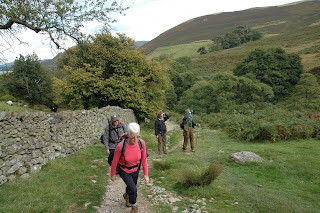The beauty of walking a country is in proximity. The bracken ferns swirl just inches from your feet. Ullswater, the second largest of the ponds in England’s famed Lake District, falls serenely to one side, while fells reach to the side along another.
A man with his string of hounds passes you up, nods, keeps moving. A family with a baby too young to walk himself waves at the intersection of the next footpath. Sweet little slippers in pink and poppy-like blooms in yellow line the lane. Cattle guards that are no more than a nuisance in a car become cause for contemplation as you skirt them and slip through the stile instead; are they meant to secure beef cattle or milking ones, woolly maggots (as someone along the way has called sheep) or lambs that may be stewed for dinner? 
The air is so clean and crisp that finicky lichens cling to the moist, north side of the trees; it bears no scent save the juniper berries you’ve picked and crushed in your hand, or the spoke from the fire that beckons once you’re finally close to your inn.
The drawback to walking is sore feet and a gloomy day. The misty beauty is alluring and otherworldly…but perhaps best enjoyed from a window by the fire.
Once, that fireside seat might have been the best recourse for the weary and wet. But for the past seven years, there’s been the Rheged Centre, the dreamchild of a local farmer-turned-businessman.
The descriptions make this sound like one of those wayside stop best avoided, but in fact the place is charming: a showcase for local crafts, papers, cards, wines, cheeses, jams, fruits; and a place where you can get a reasonably priced, yummy meal of local ingredients. Or you can watch a large-format film about the region of Cumbria or Everest or the Shacketon expedition, or take children in to the surprisingly expansive play area to paint and fire a pot or draw or try another pastime.
But the exhibit that most drew our attention was the National Mountaineering Exhibit. Cumbria claims bragging rights as the birthplace of rockclimbing, a miniature – by alpine standard – obstacle course of spires and cliff faces. But even if the idea of strapping on crampons and hauling yourself of a vertical cliff isn’t a turn-on, this exhibit may be for you, for much of it is dedicated to Mallory and Irvine’s early attempt on Everest, and stirs the contemplation over whether the pair might well have summitted the peak 29 years before Hillary and Tenzing.
Since Mallory and Irvine died in the attempt, and their camera has yet to be found, there’s no record. But the exhibition includes items found on Mallory’s body when it was chipped from the ice in the late 1990s: the nametag sewn into his shirt, the tailor’s accounting of his outstanding bill, the shoes on his feet.
Robin Ashcroft, who directs the exhibition, thinks it’s quite possible the pair made the summit and died on the descent. But he doesn’t want to know for sure, he says. Mystery is sometimes more satisfying than knowledge.
Wednesday, October 03, 2007
Sore feet and rainy days
Posted by
DARCOS CRUZ
at
12:52 AM
![]()
![]()
Subscribe to:
Post Comments (Atom)




No comments:
Post a Comment